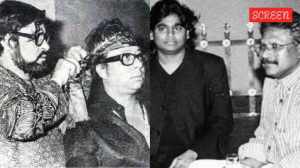Chandigarh Hospice completes 20 years of service: ‘More such facilities are the need of the hour’
With the vision to provide compassionate and qualitative care, the hospice has served around 21,000 patients to date in its three-level care facility -- outpatient clinic, home care and inpatient unit hospice, and around 500 patients are admitted to the hospice every year.
 The Chandigarh Hospice, Sector 43, was inaugurated on January 14, 2003, for terminally ill cancer patients who needed pain management and supportive care. (Representational/File)
The Chandigarh Hospice, Sector 43, was inaugurated on January 14, 2003, for terminally ill cancer patients who needed pain management and supportive care. (Representational/File) The Chandigarh Hospice and Palliative Care Services Project was set up for terminally ill cancer patients who needed pain management and supportive care. Since 1998, the palliative outpatient clinic has been functioning at the Radiotherapy Department of PGI from Monday to Friday which is supported by the UT Red Cross by deputing a specially trained doctor and a nurse for the clinic. A psychologist also volunteers to counsel the patients in the clinic and the patients requiring symptom management and end of lifecare are being seen in this clinic.
Some cancer patients may need institutional care at the end stage of their illness. Instead of admitting them in busy acute care hospitals, they require a care unit which combines the skills of a hospital with the hospitality and warmth of a home. The Chandigarh Hospice, Sector 43, was inaugurated on January 14, 2003, for terminally ill cancer patients who needed pain management and supportive care.
This is a free 15-bedded indoor service which has been financially managed by the Indian Red Cross Society, UT, for the last 20 years. The aim is to empower caregivers and to let the patients be in comfort and pain-free in the last days of their lives. Hospice care not only provides medical and nursing care to patients in a homely atmosphere but also saves acute bed occupancy in active treating hospitals. When the hospice was started, it was decided to involve the community to support this service.
Fortunately, the community has contributed immensely to the service in the last two decades, with individuals, NGOs, CSR initiatives supporting every need of the hospice. Since 1998, the palliative outpatient clinic has been functioning at the Radiotherapy Department of PGI from Monday to Friday, which is supported by the UT Red Cross by deputing a specially trained doctor and a nurse for the clinic. It is from here that patients are referred to the hospice.
On completion of 20 years of service by hospice on Thursday, Founder’s Day and lohri was celebrated at the hospice, with Secretary (Health) Yashpal Garg, members of the Red Cross, representatives of supporting NGOs, faculty from the Departments of Radiotherapy and Oncology, PGI, members of CII IWN and individual supporters for the cause part of the occasion.
With the vision to provide compassionate and qualitative care, the hospice has served around 21,000 patients to date in its three-level care facility — outpatient clinic, home care and inpatient unit hospice, and around 500 patients are admitted to the hospice every year.
Believing in the philosophy of ‘Care Beyond Cure’, the service aims to let people with advanced cancer live with dignity and comfort and the system adjusts to the needs of the patients and their caregivers.
Dr Firuza Patel, former professor, at the Department of Radiotherapy, PGI, is the mentor of this service and recalled how what began as a thought to give patients in the advanced stage of cancer care, is now probably the only hospice in the entire Northern region. “All patients come through the PGI and the doctors decide if they require the services of the hospice, and how long they will stay, with many patients travelling from across the region for treatment. This hospice is run entirely on donations, the support of people and the selfless service of doctors, and the need of the hour is to have more such facilities across the region and support from all quarters and today, I want to thank everyone, who has been part of this journey,” said Dr Patel.
The UT Red Cross had recently requested the Rogi Kalyan Samiti Executive Committee to provide financial assistance to run the hospice project in larger public interest. The committee has approved that 20% of the rental income being earned by GMSH-16 from the allotted shops/canteen be shared with the UT Red Cross, with the stipulation that this arrangement will continue till grant-in-aid is provided to the Red Cross Society by the Chandigarh Administration or till December 31, 2023, whichever is earlier.
Dr Sushmita Ghoshal, Professor and Head, Department of Radiotherapy, PGI, says that the importance of these services in society are paramount and need to thrive, with more such facilities urgently needed. “Many cancer patients we are treating cannot be cured, but they all need to live with dignity, without pain, and receive care, compassion, support, trained help and medical care which makes their condition comfortable. With nuclear families and a consumerist society, these are the services which are needed in the future, and as people living in a civilised society, we must consider the welfare of others, for all of us need love. Not just the patients, the hospice caters to the needs of the caregivers and students must be encouraged to do voluntary work here and we all must come together to do our bit.”












